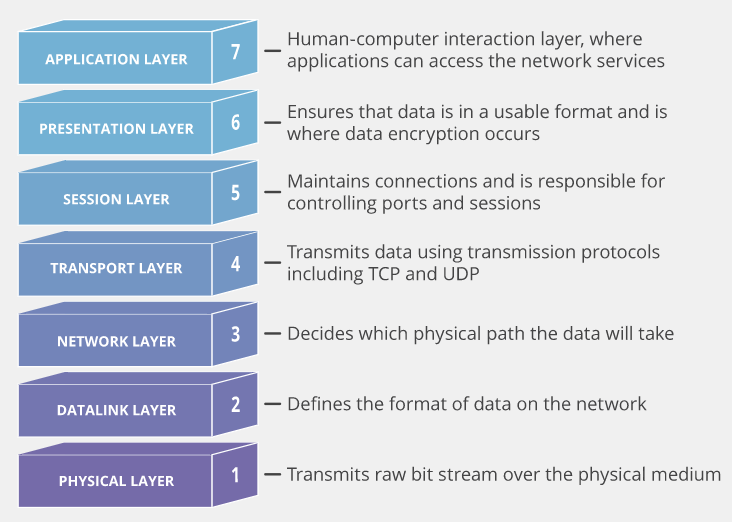OSI model: Difference between revisions
Mr. MacKenty (talk | contribs) No edit summary |
Mr. MacKenty (talk | contribs) No edit summary |
||
| (9 intermediate revisions by the same user not shown) | |||
| Line 3: | Line 3: | ||
'''Please Do Not Touch Steve’s Pet Alligator!!''' | '''Please Do Not Touch Steve’s Pet Alligator!!''' | ||
In the context of computer networking, communication is often broken down into different layers, each with a specific purpose and role. These layers are called the "OSI model" or the "OSI reference model," and they are as follows: | |||
# Physical layer: This layer is concerned with the transmission of raw data over a physical medium, such as a copper wire or a fiber optic cable. It defines things like the type of cable to be used and the signaling method for transmitting data. | |||
# Data link layer: This layer is responsible for creating a reliable link between devices on a network. It does this by adding a layer of error-checking to the data transmitted at the Physical layer, ensuring that the data arrives at its destination without any errors. | |||
# Network layer: This layer is responsible for routing data between devices on a network. It determines the best path for data to travel and ensures that it gets to its destination by passing it from one device to another until it reaches its destination. | |||
# Transport layer: This layer is responsible for ensuring that data is delivered reliably and in the correct order. It does this by adding features such as error correction and flow control to the data transmitted at the lower layers. | |||
# Session layer: This layer is responsible for establishing, maintaining, and terminating connections between devices on a network. It ensures that data is exchanged correctly between devices, even if the connection is temporarily lost. | |||
# Presentation layer: This layer is responsible for formatting and encoding data so that it can be understood by the application that is receiving it. It may also perform tasks such as data compression and encryption. | |||
# Application layer: This is the top layer of the OSI model, and it is the layer that is most visible to users. It is responsible for providing network services to applications and allowing them to access the network. | |||
In summary, the OSI model breaks down communication over networks into seven different layers, each with a specific role and purpose in the process of transmitting data from one device to another. | |||
There are two things you need to do here: | |||
1. simply state two layers (just their names) | |||
2. you MUST be able to describe how communication is broken down into layers | |||
== Graphic == | |||
I use this excellent diagram from Cloudflare<ref>https://www.cloudflare.com/learning/ddos/glossary/open-systems-interconnection-model-osi/</ref> | |||
[[File:Osi model.png|illustration of OSI model]] | |||
== Standards == | == Standards == | ||
| Line 29: | Line 31: | ||
<references /> | <references /> | ||
[[Category:networks]] | [[Category:networks]] | ||
[[Category: | [[Category:formative assessment]] | ||
Latest revision as of 14:41, 8 January 2023

Networks[1]
Please Do Not Touch Steve’s Pet Alligator!!
In the context of computer networking, communication is often broken down into different layers, each with a specific purpose and role. These layers are called the "OSI model" or the "OSI reference model," and they are as follows:
- Physical layer: This layer is concerned with the transmission of raw data over a physical medium, such as a copper wire or a fiber optic cable. It defines things like the type of cable to be used and the signaling method for transmitting data.
- Data link layer: This layer is responsible for creating a reliable link between devices on a network. It does this by adding a layer of error-checking to the data transmitted at the Physical layer, ensuring that the data arrives at its destination without any errors.
- Network layer: This layer is responsible for routing data between devices on a network. It determines the best path for data to travel and ensures that it gets to its destination by passing it from one device to another until it reaches its destination.
- Transport layer: This layer is responsible for ensuring that data is delivered reliably and in the correct order. It does this by adding features such as error correction and flow control to the data transmitted at the lower layers.
- Session layer: This layer is responsible for establishing, maintaining, and terminating connections between devices on a network. It ensures that data is exchanged correctly between devices, even if the connection is temporarily lost.
- Presentation layer: This layer is responsible for formatting and encoding data so that it can be understood by the application that is receiving it. It may also perform tasks such as data compression and encryption.
- Application layer: This is the top layer of the OSI model, and it is the layer that is most visible to users. It is responsible for providing network services to applications and allowing them to access the network.
In summary, the OSI model breaks down communication over networks into seven different layers, each with a specific role and purpose in the process of transmitting data from one device to another.
There are two things you need to do here: 1. simply state two layers (just their names) 2. you MUST be able to describe how communication is broken down into layers
Graphic[edit]
I use this excellent diagram from Cloudflare[2]

Standards[edit]
- Describe how communication over networks is broken down into different layers.
- List the stages in the OSI model